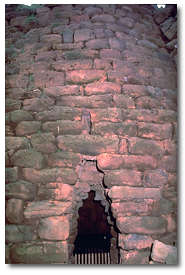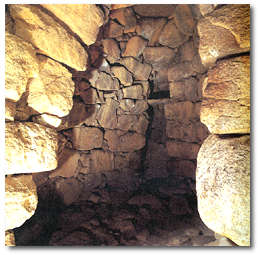
 Nuraghe Orrubiu - Orroli Nuraghe Orrubiu - Orroli |
|
When nuraghi were built with a single
tower they were often other towers built close by and they were connected to each other by large
thick walls with walkways on top of them. The complex nuraghi were built in this way: The so-called
bilobati with two extra towers; the trilobati with three extra towers; the quadrilobati with four
extra towers and the pentalobati with five extra towers.
Between the central tower and the other towers there were courtyards which allowed people to move
from one tower to another.
In the complete nuraghi external walls with towers were built. These are called a barbican.
|
The number and the location of the
towers and the courtyards varies depending on the kind of stone and the nature and morphology of the
land. So every nuraghe is a unique archaeological site that may be similar to other nuraghi but never
the same.
|
We do not know exactly how the nuraghi
were built and in particular how the stones, especially the very big stones were lifted.
Rampants, wooden rollers, rudimentary "trestles" and various other systems have all been
suggested as the method used to lift these stones, but in fact there is no scientific proof of which
if any of these methods were used.
|
|

 Nuraghe Santu Antine -Torralba Nuraghe Santu Antine -Torralba |
We do not know why any given nuraghe
was enlarged by adding various structures, nor why one or more towers were added, nor why one type of
solution was chosen rather than another one.
|

 Nuraghe Albucciu - Arzachena Nuraghe Albucciu - Arzachena |
|
Current research and the archaeological
excavations, which nowadays are carried out using sophisticated techniques and scientific methods,
should shed light on these questions and reveal some of the mysteries of the nuragic civilization.
However the hypothesis that nuraghi were part of a territorial defense system that had various units
of different kinds, from the simple control towers, to the small simple buildings, to the majestic
buildings which were probably landmarks for whole areas, is becoming more and more acceptable.
|
|